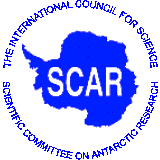|
The Antarctic
continent plays a very important role in the plate
tectonics context and its most recent revisions.
The study of the lithosphere and the
identification of relevant lateral discontinuities
in Antarctica and surrounding areas are essential
to the understanding of the geodynamic evolution
of the continent.
Studies of the
Antarctic continent rely extensively on magnetic
anomaly data, because of the extensive ice cover.
Numerous magnetic surveys have been carried out by
the international community. The objective for
compiling the Antarctic digital magnetic database
is to enhance the geological and tectonic utility
of these magnetic data. This compilation will
provide an improvement in understanding the
regional geology of the Antarctic, provide a
regional framework for the interpretation of
smaller scale areas and enable a more effective
selection of areas for further investigation.
The
multinational Antarctic Digital Magnetic Anomaly
Project (ADMAP) has been launched to compile
near-surface and satellite magnetic anomaly data
into a digital map and database for the
Antarctic continent and surrounding oceans. The
unified data set will be a powerful tool for
determining the structure, processes and
tectonic evolution of the continent, together
with providing information valuable in the
reconstruction of the Gondwanaland and Rodinia
supercontinents. The resulting merged potential
field anomaly maps connect geological mapping
studies of the various programmes in terms of
parameters such as:
- major
structure and composition of the continent. The
magnetic (and gravity) data provide
2-dimensional regional maps of structural grain
in basement; suture zones between basement
terranes; the basement terranes themselves; the
nature of intra continental rifts and the extent
of major faults;
- geological
timing and kinematics associated with the
evolution of the continent. Relative ages and
displacements can be derived from the detailed
geophysical mapping of rock units. The
distinctive magnetic signatures of some plutons,
serpentinites, amphibolites, migmatites, young
sedimentary basins and volcanic rocks provide
important markers for extracting both the
orientation of regional faulting and relative
timing;
- information
on the isostatic state of the lithosphere
contained in long wavelength magnetic anomalies,
because the lower crust is a zone of strongly
enhanced magnetisation with respect to the upper
crust and mantle. Magnetic data, especially in
combination with correlative gravity
observations, can provide significant insight
into the thermal structure of the Antarctic
lithosphere;
- paleoenvironment
and
global change; from the reconstruction of
Gondwana, it might be possible to identify the
locations of old oceans and therefore infer
circulation paths that would have affected past
climates;
- essential
information on the crustal contribution to the
Earth's magnetic field from a remote and
poorly understood region. This effort will
permit improved global geomagnetic field
modelling and assist with verification and
calibration of magnetometer observations
obtained from polar orbiting satellite
missions (e.g. POGO, Magsat, Orsted). The
integration of satellite and near-surface
magnetic anomalies will result in a
compilation that accurately portrays the
fullest possible spectrum of magnetic
anomalies for the Antarctic lithosphere.
|






















